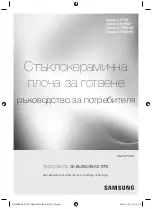
GB
22
Precautions and tips
! This appliance has been designed and manufactured in
compliance with international safety standards. The
following warnings are provided for safety reasons and
must be read carefully.
General safety
• This is a appliance.
- Category II 2H3+ ; all models
- Class 1: all models with edges that are higher than
58mm (see overleaf, Fig. 2, detail H3).
- Class 3: all models with edges that are lower than 58
mm (see overleaf, Fig. 2, details H1 and H2).
Gas appliances require regular air exchange in order to
maintain efficient operation. When installing the hob,
follow the instructions provided in the paragraph
relating to “Positioning” the appliance.
• These instructions are only valid for the countries whose
symbols appear in the manual and on the serial
number plate.
• The appliance was designed for domestic use inside
the home and is not intended for commercial or
industrial use.
• The appliance must not be installed outdoors, even in
covered areas. It is extremely dangerous to leave the
appliance exposed to rain and storms.
• Do not touch the appliance with bare feet or with wet or
damp hands and feet.
•
The appliance must be used by adults only for the
preparation of food, in accordance with the
instructions outlined in this booklet. Any other use
of the appliance (e.g. for heating the room)
constitutes improper use and is dangerous. The
manufacturer may not be held liable for any
damage resulting from improper, incorrect and
unreasonable use of the appliance.
• Make sure that the power supply cables of other
electrical appliances do not come into contact with the
hot parts of the oven.
• The openings used for the ventilation and dispersion of
heat must never be covered.
• Always make sure the knobs are in the
“
”/“
”
position
when the appliance is not in use.
• When unplugging the appliance, always pull the plug
from the mains socket; do not pull on the cable.
• Never perform any cleaning or maintenance work
without having disconnected the appliance from the
electricity mains.
• If the appliance breaks down, under no circumstances
should you attempt to perform the repairs yourself.
Repairs carried out by inexperienced persons may
cause injury or further malfunctioning of the appliance.
Contact an Assistance Centre (see Assistance).
• Always make sure that pan handles are turned towards
the centre of the hob in order to avoid accidental burns.
• Do not close the glass cover (if present) while the gas
burners or electric hotplates are still hot.
• Do not use unstable or warped pans.
• As it is a potential hazard, make sure that children and
disabled individuals do not have access to the glass
ceramic cooking zones (if present) during and
immediately after cooking, as these zones remain hot
for at least half an hour after they have been switched
off.
• If the glass ceramic surface breaks, please contact any
assistance centre which has been authorised by the
manufacturer.
• If the glass ceramic surface breaks, it is best to
disconnect the appliance from the electricity supply.
• Remove any liquids on the cover before opening it.
• The appliance is not intended for use by people
(including children) with reduced physical, sensory or
mental capacities or by those unfamiliar or
inexperienced with the appliance, unless adequately
supervised by a person in charge of their safety or
unless they have been supplied with preliminary
instructions regarding appliance use.
• Do not let children play with the appliance.
• Intensive and prolonged operation of the appliance
may require additional ventilation, for example a
window should be opened or more efficient ventilation
provided (the power of any mechanical ventilation
system could be increased, for instance).
•
The appliance is not intended to be operated by
means of an external timer or separate remote-
control system.
Disposal
• When disposing of packaging material: observe local
legislation so that the packaging may be reused.
• The European Directive 2002/96/EC on Waste Electrical
and Electronic Equipment (WEEE), requires that old
household electrical appliances must not be disposed
of in the normal unsorted municipal waste stream. Old
appliances must be collected separately in order to
optimise the recovery and recycling of the materials
they contain and reduce the impact on human health
and the environment. The crossed out “wheeled bin”
symbol on the product reminds you of your obligation,
that when you dispose of the appliance it must be
separately collected.
Consumers may take their old appliance to public
waste collection areas, other communal collection
areas, or if national legislation allows return it to a
retailer when purchasing a similar new product.
All major household appliance manufacturers are active
in the creation of systems to manage the collection and
disposal of old appliances.
















































